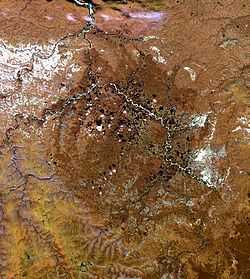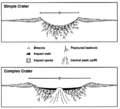Popigai crater

The Popigai crater (or astrobleme) in Siberia, Russia is tied with the Manicouagan Crater as the seventh largest verified impact crater on Earth.[1][2] A large bolide impact created the 100 kilometres (62 mi) diameter crater approximately 35 million years ago during the late Eocene epoch (Priabonian stage).[3][4] The crater is 300 km east from the outpost of Khatanga and 880 km (550 mi) NE of the city of Norilsk. It is designated by UNESCO as a Geopark, a site of special geological heritage.[5]
Popigai is the best example yet of the formation of a crater of this type. Six other craters are larger; some are either buried (Chicxulub), strongly deformed (Sudbury), or deformed and severely eroded (Vredefort).
There is a small possibility that Popigai impact crater formed simultaneous with the approximately 35 million year old Chesapeake Bay and Toms Canyon impact craters.[3]
For decades the Popigai crater has fascinated paleontologists and geologists, but the entire area was completely off limits because of the diamonds and the mines constructed by gulag prisoners under Stalin; however, a major investigatory expedition was undertaken in 1997, which greatly advanced understanding of the enigmatic structure.[5] The impactor in this event has been identified as either an 8 km (5.0 mi) diameter chondrite asteroid, or a 5 km (3.1 mi) diameter stony asteroid.
The shock pressures from the impact instantaneously transformed graphite in the ground into diamonds within a 13.6 km (8.5 mi) radius of the impact point. These diamonds are usually 0.5 to 2 mm (0.020 to 0.079 in) in diameter, though a few exceptional specimens are 10 mm (0.39 in) in size. The diamonds not only inherited the tabular shape of the original graphite grains but they additionally preserved the original crystals' delicate striations.[5]
Diamond mines
In September 2012, Russia officially stated there are massive diamond reserves under the mines containing "trillions of carats" (hundreds of thousands of tons) and claimed there are enough diamonds in the field to supply global requirements for 3,000 years. This could alter the market for industrial diamonds, presumably by making them more plentiful and lower cost. However, most modern industrial diamonds are produced synthetically, so the deposits at Popigai may not be profitable because of the remote location and difficulty of extraction.[6] Many of the diamonds at Popigai contain crystalline lonsdaleite, an allotrope of carbon that has a hexagonal lattice. [7] Pure, laboratory-created lonsdaleite is 58% harder than ordinary diamonds,[8] though it is unknown whether the natural, impure examples at Popigai show similar characteristics.[6] The diamonds also "contain unusual abrasive features and large grain size" which could make them extremely useful for industrial and scientific applications. These types of diamonds are known as "impact diamonds" because they are thought to be produced when a meteorite strikes a graphite deposit at high velocity.[7] They may have industrial uses but are considered unsuitable as gems.[9]
Additionally, carbon polymorphs even harder than lonsdaleite have been discovered in the crater.[10]
References
- ↑ "Popigai". Earth Impact Database. University of New Brunswick. Retrieved 2008-12-30.
- ↑ Masaitis, Victor L. (2003). Popigai Crater: General Geology. Springer. pp. 81–85. ISBN 978-3-540-43517-4.
- ↑ 3.0 3.1 Deutsch, Alexander; Christian Koeberl (2006). "Establishing the link between the Chesapeake Bay impact structure and the North American tektite strewn field: The Sr-Nd isotopic evidence". Meteoritics & Planetary Science 41 (5): 689–703. Bibcode:2006M&PS...41..689D. doi:10.1111/j.1945-5100.2006.tb00985.x. Retrieved 2008-06-16.
- ↑ Armstrong, Richard; S. Vishnevsky & C. Koeberl (2003). U-Pb Analysis of zircons from the Popigai impact structure, Russia: First Results. Springer. pp. 99–116. ISBN 978-3-540-43517-4.
- ↑ 5.0 5.1 5.2 Deutsch, Alexander; V.L. Masaitis, F. Langenhorst & R.A.F. Grieve (2000). "Popigai, Siberia—well preserved giant impact structure, national treasury, and world's geological heritage". Episodes 23 (1): 3–12. Retrieved 2008-06-16.
- ↑ 6.0 6.1 "Diamonds Beneath the Popigai Crater -- Northern Russia". geology.com. 23 September 2012. Retrieved 24 September 2012.
- ↑ 7.0 7.1 "Russia declassifies deposit of impact diamonds". ITAR-TASS. 17 September 2012. Retrieved 17 September 2012.
- ↑ Pan, Zicheng; Sun, Hong; Zhang, Yi; and Chen, Changfeng (2009). "Harder than Diamond: Superior Indentation Strength of Wurtzite BN and Lonsdaleite". Physical Review Letters 102 (5): 055503. Bibcode:2009PhRvL.102e5503P. doi:10.1103/PhysRevLett.102.055503. PMID 19257519. Lay summary – Physorg.com (12-02-2009).
- ↑ Pros and cons of extraterrestrial diamonds, from "Rough&Polished–information and analytics on diamond and jewellery markets."
- ↑ El Goresy et al, "A new natural, super-hard, transparent polymorph of carbon from the Popigai impact crater, Russia", Comptes Rendus Geoscience 335:12 (October 2003), pp. 889–898. doi:10.1016/j.crte.2003.07.001
External links
Coordinates: 71°39′N 111°11′E / 71.650°N 111.183°E

